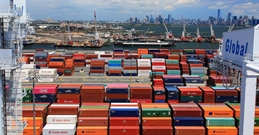
The Port of New York and New Jersey announced that it will implement a new quarterly container imbalance fee for ocean carriers as part of the seaport's multi-pronged effort to aggressively move to handle record cargo volumes spurred by peak cargo season and a cargo shift from the West Coast.
The Port Authority of New York and New Jersey said the container management fee, targeting excess empty containers being stored in the port for long periods, will be effective as of September 1, 2022, pending a mandatory federal 30-day notice period.
It said the fee will reduce the number of excess empty containers dwelling at the port and free up much-needed capacity for containers that are full of imports and ready to be picked up by cargo owners.
"As part of its ongoing strategic planning efforts to encourage all players involved in the cargo shipping community to make substantial capacity improvements elsewhere in the supply chain to accommodate this tremendous growth, the Port Authority is taking proactive steps as the East Coast's largest container port prepares for what is traditionally its busiest annual period ahead of the US holiday shopping season," the Port Authority said.
In its announcement, the Port Authority added that the seaport has been handling a cargo increase of nearly 12% year-to-date compared to the same period last year and an astounding rise of 34% in cargo volume compared to the same period during pre-pandemic 2019.
"We rely heavily on our port partners as the downstream links in a vast global supply chain that needs full cooperation in order for international commerce to function and deliver the essential goods that the region's residents need," said Kevin O'Toole, Port Authority chairman.
"As we continue to manage record cargo volume and work with our tenants and port stakeholders for the removal of empty containers in a timely manner, we call on all industry stakeholders to find sustainable, long-term solutions to an industrywide problem affecting many US ports."
Rick Cotton, Port Authority executive director, noted that the port must use "every tool" to ensure that the flow of goods and business will continue.
"Our seaport has largely managed to avoid many of the national supply chain challenges affecting other U.S. ports ... This new proactive container management approach is an example of our Port Department's ability to identify and implement solutions before they cause logjams in our region," he said.
Record volumes piling up empty containers
"The Port of New York and New Jersey is facing record import volumes, leading to empty containers accumulating in and around the port complex that are now affecting the regional supply chain that is already under stress from various sources across the country," commented Bethann Rooney, director of the Port Department at the Port Authority of New York and New Jersey.
"We emphatically encourage ocean carriers to step up their efforts to evacuate empty containers quicker and at higher volumes to free up much-needed capacity for arriving imports in order to keep commerce moving through the port and the region."
The Port Authority noted that the container imbalance fee will be assessed on ocean carriers who do not evacuate empty containers that take up sorely needed space for arriving imports and impede overall port productivity and fluidity.
"Under this new container management fee, which will be assessed on a quarterly basis, ocean carriers' total outgoing container volume must equal or exceed 110% of their incoming container volume during the same period, or they will be assessed a fee of US$100 per container for failing to hit this benchmark," the announcement said.
It added that incoming and outgoing containers include both loaded and empty containers, excluding rail volume.
Temporary storage for empty containers
The Port Authority said fee proceeds will be used to offset the costs of providing additional storage capacity and other expenses incurred by the glut of empty containers.
In addition to the fee, the Port Authority said it has taken other steps to manage the empty containers, including the repurposing of 12 acres within Port Newark and the Elizabeth-Port Authority Marine Terminal for the temporary storage of empty containers and long-dwelling import containers, and is in the process of negotiating or investigating additional storage space.
The fee will be reassessed when the global supply chain crisis eases, with a review as needed to the agency's Board of Commissioners no later than September 2023.



